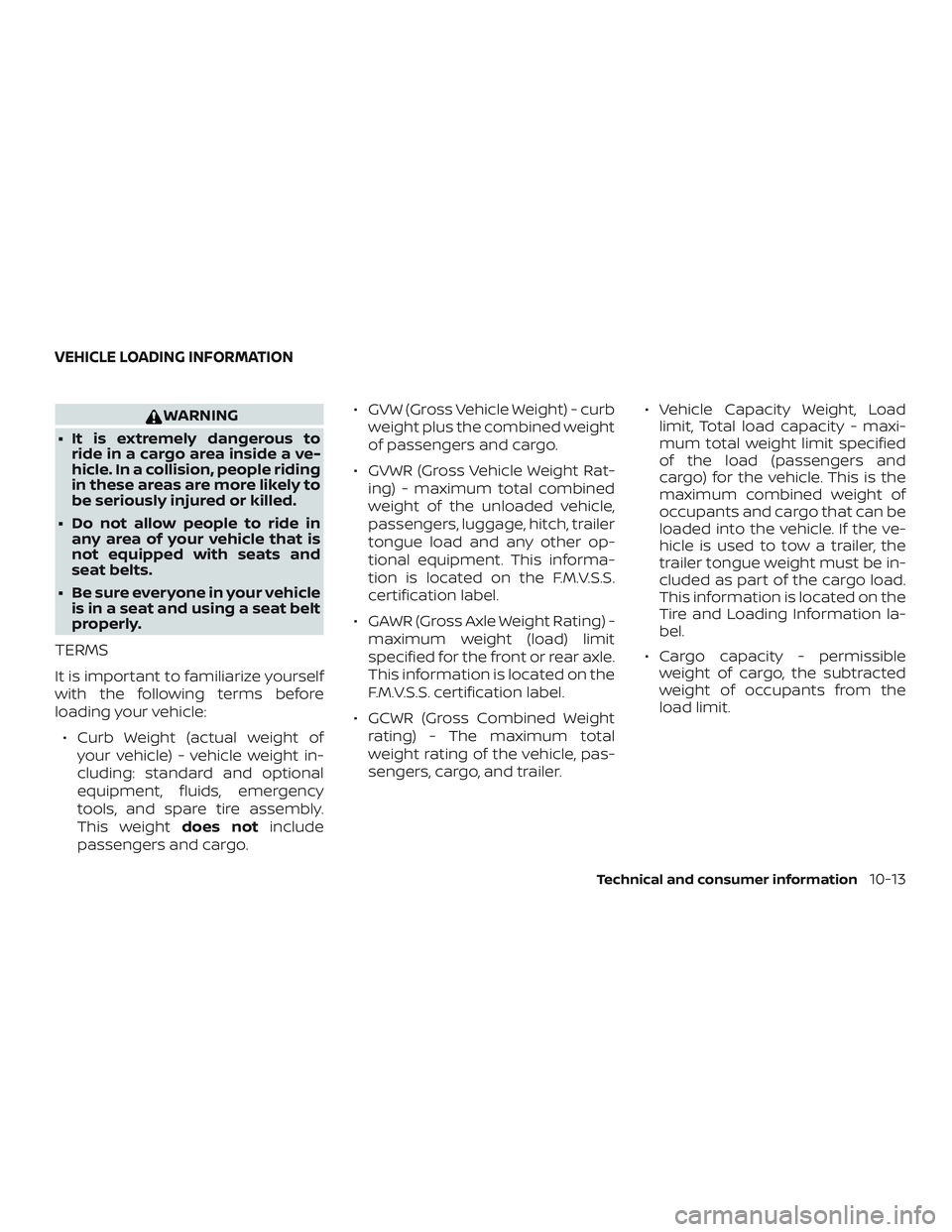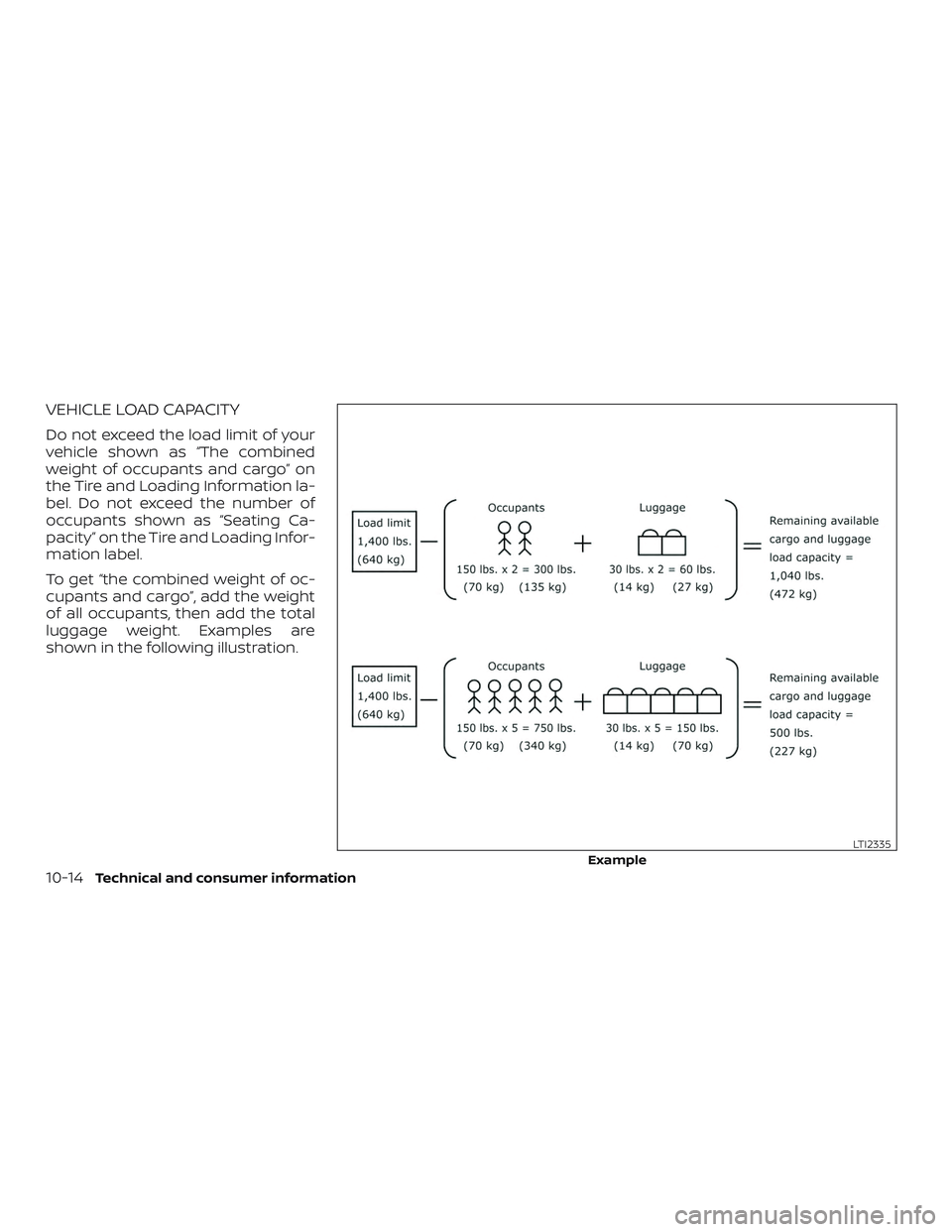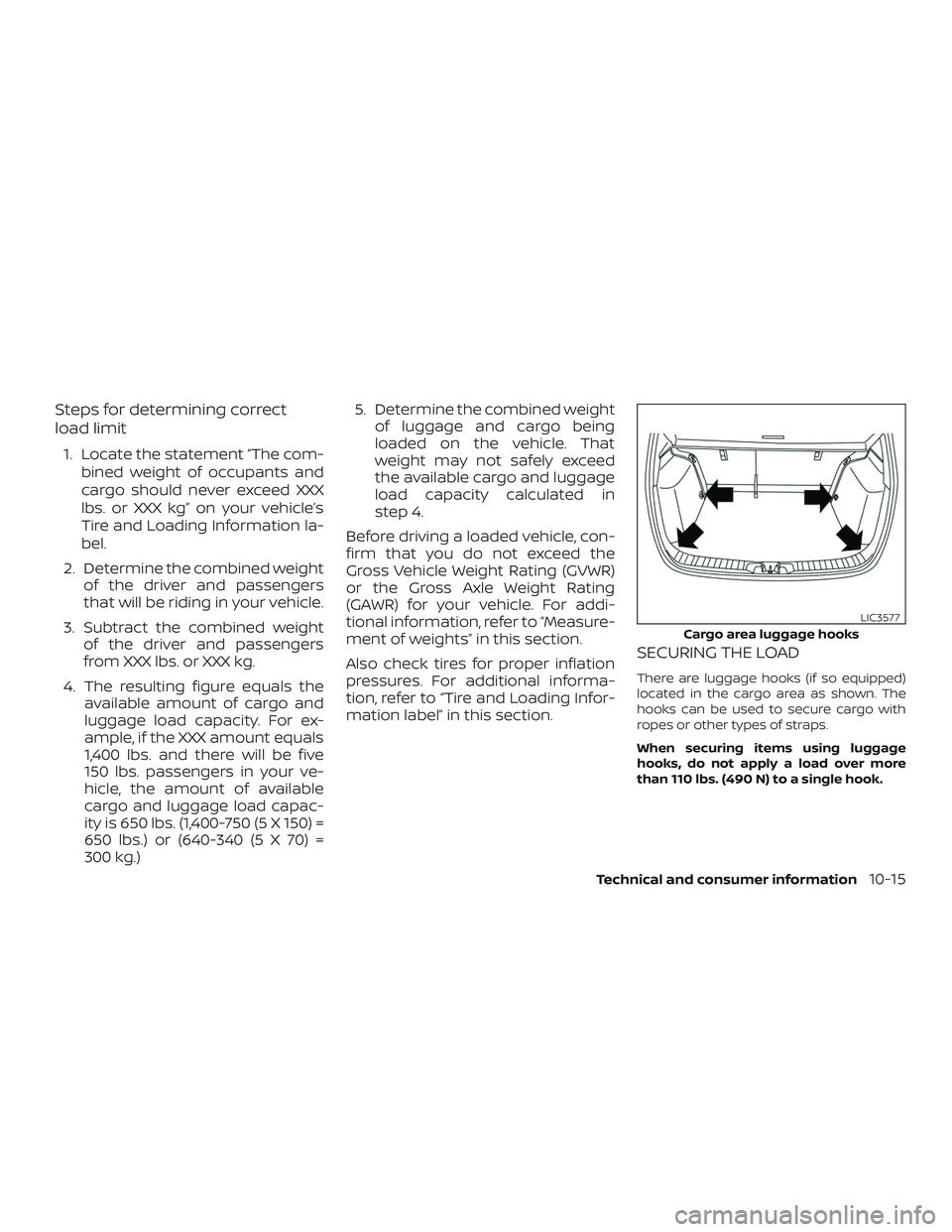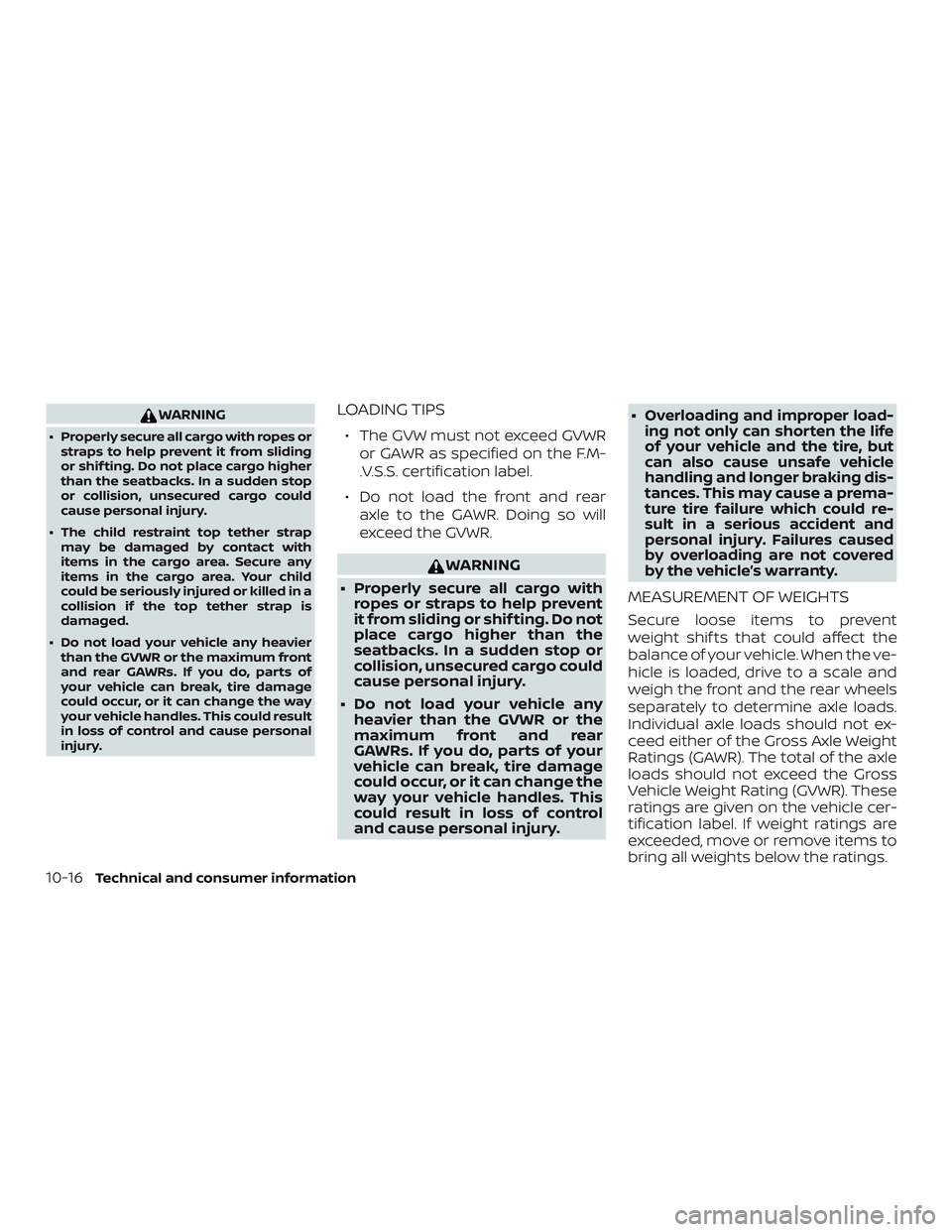2018 NISSAN LEAF weight
[x] Cancel search: weightPage 415 of 435

ENGINE SERIAL NUMBER
The number is stamped on the engine as
shown.
F.M.V.S.S./C.M.V.S.S. CERTIFICATION
LABEL
The Federal/Canadian Motor Vehicle
Safety Standard (F.M.V.S.S./C.M.V.S.S.) certifi-
cation label is affixed as shown. This label
contains valuable vehicle information, such
as: Gross Vehicle Weight Ratings (GVWR),
Gross Axle Weight Rating (GAWR), month
and year of manufacture, Vehicle Identifi-
cation Number (VIN), etc. Review it carefully.
EMISSION CONTROL
INFORMATION LABEL
The emission control information label is
attached to the underside of the hood as
shown.
HR16DE engine
LTI2260WTI0172LTI2268
Technical and consumer information10-11
Page 417 of 435

WARNING
∙ It is extremely dangerous to ride in a cargo area inside a ve-
hicle. In a collision, people riding
in these areas are more likely to
be seriously injured or killed.
∙ Do not allow people to ride in any area of your vehicle that is
not equipped with seats and
seat belts.
∙ Be sure everyone in your vehicle is in a seat and using a seat belt
properly.
TERMS
It is important to familiarize yourself
with the following terms before
loading your vehicle:
∙ Curb Weight (actual weight of your vehicle) - vehicle weight in-
cluding: standard and optional
equipment, fluids, emergency
tools, and spare tire assembly.
This weight does notinclude
passengers and cargo. ∙ GVW (Gross Vehicle Weight) - curb
weight plus the combined weight
of passengers and cargo.
∙ GVWR (Gross Vehicle Weight Rat- ing) - maximum total combined
weight of the unloaded vehicle,
passengers, luggage, hitch, trailer
tongue load and any other op-
tional equipment. This informa-
tion is located on the F.M.V.S.S.
certification label.
∙ GAWR (Gross Axle Weight Rating) - maximum weight (load) limit
specified for the front or rear axle.
This information is located on the
F.M.V.S.S. certification label.
∙ GCWR (Gross Combined Weight rating) - The maximum total
weight rating of the vehicle, pas-
sengers, cargo, and trailer. ∙ Vehicle Capacity Weight, Load
limit, Total load capacity - maxi-
mum total weight limit specified
of the load (passengers and
cargo) for the vehicle. This is the
maximum combined weight of
occupants and cargo that can be
loaded into the vehicle. If the ve-
hicle is used to tow a trailer, the
trailer tongue weight must be in-
cluded as part of the cargo load.
This information is located on the
Tire and Loading Information la-
bel.
∙ Cargo capacity - permissible weight of cargo, the subtracted
weight of occupants from the
load limit.
VEHICLE LOADING INFORMATION
Technical and consumer information10-13
Page 418 of 435

VEHICLE LOAD CAPACITY
Do not exceed the load limit of your
vehicle shown as “The combined
weight of occupants and cargo” on
the Tire and Loading Information la-
bel. Do not exceed the number of
occupants shown as “Seating Ca-
pacity” on the Tire and Loading Infor-
mation label.
To get “the combined weight of oc-
cupants and cargo”, add the weight
of all occupants, then add the total
luggage weight. Examples are
shown in the following illustration.
Example
LTI2335
10-14Technical and consumer information
Page 419 of 435

Steps for determining correct
load limit
1. Locate the statement “The com-bined weight of occupants and
cargo should never exceed XXX
lbs. or XXX kg” on your vehicle’s
Tire and Loading Information la-
bel.
2. Determine the combined weight of the driver and passengers
that will be riding in your vehicle.
3. Subtract the combined weight of the driver and passengers
from XXX lbs. or XXX kg.
4. The resulting figure equals the available amount of cargo and
luggage load capacity. For ex-
ample, if the XXX amount equals
1,400 lbs. and there will be five
150 lbs. passengers in your ve-
hicle, the amount of available
cargo and luggage load capac-
ity is 650 lbs. (1,400-750 (5 X 150) =
650 lbs.) or (640-340 (5 X 70) =
300 kg.) 5. Determine the combined weight
of luggage and cargo being
loaded on the vehicle. That
weight may not safely exceed
the available cargo and luggage
load capacity calculated in
step 4.
Before driving a loaded vehicle, con-
firm that you do not exceed the
Gross Vehicle Weight Rating (GVWR)
or the Gross Axle Weight Rating
(GAWR) for your vehicle. For addi-
tional information, refer to “Measure-
ment of weights” in this section.
Also check tires for proper inflation
pressures. For additional informa-
tion, refer to “Tire and Loading Infor-
mation label” in this section.
SECURING THE LOAD
There are luggage hooks (if so equipped)
located in the cargo area as shown. The
hooks can be used to secure cargo with
ropes or other types of straps.
When securing items using luggage
hooks, do not apply a load over more
than 110 lbs. (490 N) to a single hook.
Cargo area luggage hooks
LIC3577
Technical and consumer information10-15
Page 420 of 435

WARNING
∙ Properly secure all cargo with ropes orstraps to help prevent it from sliding
or shif ting. Do not place cargo higher
than the seatbacks. In a sudden stop
or collision, unsecured cargo could
cause personal injury.
∙ The child restraint top tether strap may be damaged by contact with
items in the cargo area. Secure any
items in the cargo area. Your child
could be seriously injured or killed in a
collision if the top tether strap is
damaged.
∙ Do not load your vehicle any heavier than the GVWR or the maximum front
and rear GAWRs. If you do, parts of
your vehicle can break, tire damage
could occur, or it can change the way
your vehicle handles. This could result
in loss of control and cause personal
injury.
LOADING TIPS
∙ The GVW must not exceed GVWR
or GAWR as specified on the F.M-
.V.S.S. certification label.
∙ Do not load the front and rear axle to the GAWR. Doing so will
exceed the GVWR.
WARNING
∙ Properly secure all cargo with ropes or straps to help prevent
it from sliding or shif ting. Do not
place cargo higher than the
seatbacks. In a sudden stop or
collision, unsecured cargo could
cause personal injury.
∙ Do not load your vehicle any heavier than the GVWR or the
maximum front and rear
GAWRs. If you do, parts of your
vehicle can break, tire damage
could occur, or it can change the
way your vehicle handles. This
could result in loss of control
and cause personal injury. ∙
Overloading and improper load-
ing not only can shorten the life
of your vehicle and the tire, but
can also cause unsafe vehicle
handling and longer braking dis-
tances. This may cause a prema-
ture tire failure which could re-
sult in a serious accident and
personal injury. Failures caused
by overloading are not covered
by the vehicle’s warranty.
MEASUREMENT OF WEIGHTS
Secure loose items to prevent
weight shif ts that could affect the
balance of your vehicle. When the ve-
hicle is loaded, drive to a scale and
weigh the front and the rear wheels
separately to determine axle loads.
Individual axle loads should not ex-
ceed either of the Gross Axle Weight
Ratings (GAWR). The total of the axle
loads should not exceed the Gross
Vehicle Weight Rating (GVWR). These
ratings are given on the vehicle cer-
tification label. If weight ratings are
exceeded, move or remove items to
bring all weights below the ratings.
10-16
Technical and consumer information
Page 428 of 435

Cargocover...................2-53
Cargo (See vehicle loading
information)..................10-13
Car phone or CB radio............4-68
Check tire pressure ..............2-31
Childrestraints........1-18, 1-19, 1-21, 1-23 LATCH (Lower Anchors and Tethers
forCHildren)System ...........1-23
Precautions on child
restraints.........1-21, 1-28, 1-34, 1-39
Top tether strap anchor point
locations.................. .1-25
Child restraint with top tether strap . . . .1-25
Child safety rear door lock ..........3-6
Chimes, audible reminders .........2-20
Cleaningexteriorandinterior......7-2,7-4
Clockset.....................4-6
Coldweatherdriving.............5-61
Continuously Variable Transmission
(CVT) .......................5-15
Continuously Variable Transmission
(CVT) fluid ...................8-9
Driving with Continuously Variable
Transmission (CVT) ............5-15
Transmission shif t selector
lockrelease.................5-18
Control panel buttons .............4-3
Brightness/contrast button .......4-8
Controls Audio controls (steering wheel) .....4-63
Heater and air conditioner controls
(automatic).................4-39
Heater and air conditioner controls
(manual) ...................4-31 Coolant
Capacities and recommended
fuel/lubricants...............10-2
Changing engine coolant .........8-5
Checking engine coolant level ......8-5
Corrosionprotection..............7-7
Cruisecontrol .................5-39
Cupholders...................2-51
Curtain side-impact and rollover
airbag..................... .1-59
D
Daytime Running Light System .......2-43
Defroster switch Rear window and outside mirror
defrosterswitch...........2-40,4-41
Rear window defroster switch . .2-40, 4-33
Dimensions and weights ...........10-9
Dimmer switch for instrument panel . . .2-44
Display......................2-21
Display controls (see
control panel buttons) .............4-3
Door locks ..................3-4,3-5
Door open warning light ...........2-13
Drivebelt.....................8-13
Driving Cold weather driving ...........5-61
Driving with Continuously Variable
Transmission (CVT) ............5-15
Precautions when starting
anddriving..................5-2
Drivingthevehicle...............5-15 E
Economy - fuel .................5-51
Emergency engine shutoff ..........5-11
Emission control information label . . . .10-11
Emission control system warranty . . . .10-18
Engine Before starting the engine ........5-13
Capacities and recommended
fuel/lubricants...............10-2
Changing engine coolant .........8-5
Changing engine oil ............8-6
Changing engine oil filter .........8-8
Checking engine coolant level ......8-5
Checking engine oil level .........8-5
Engine compartment check
locations...................8-3
Engine cooling system ..........8-4
Engine oil ...................8-5
Engine oil and oil filter
recommendation .............10-6
Engine oil pressure warning light ....2-13
Engine oil viscosity .............10-6
Engine serial number ...........10-11
Engine specifications ...........10-8
Starting the engine ............5-14
EventDatarecorders............10-20
Exhaust gas (Carbon monoxide) .......
5-2
Explanation of maintenance items .....9-2
Explanation of scheduled maintenance
items .......................9-5
Extended storage switch ..........2-48
11-2
Page 433 of 435

Towing4-wheel drive models ...........6-13
Flattowing.................10-17
Trailertowing ...............10-17
Towingatrailer................10-17
Towingyourvehicle..............6-12
Transmission Continuously Variable Transmission
(CVT) fluid ...................8-9
Driving with Continuously Variable
Transmission (CVT) ............5-15
Travel (See registering a vehicle in
another country) ...............10-10
Trip odometer ...............2-5,2-6
Trunklight....................2-63
Turn signal switch ...............2-44
U
Uniform tire quality grading .........10-17
USB/iPod® Charging Ports .........4-64
USB (Universal Serial Bus) Connection Port
(models without Navigation System) . . .4-53
V
Vanitymirror..................3-27
Variable voltage control system ......8-13
Vehicle dimensions and weights ......10-9
Vehicle Dynamic Control (VDC)
OFFswitch...................2-47
Vehicle dynamic control (VDC) system . .5-56
Vehicle Dynamic Control (VDC) system . .5-56
Vehicle identification .............10-10 Vehicle identification number (VIN)
. . . .10-10
Vehicle identification number (VIN)
(Chassis number) ...............10-10
Vehicle identification number (VIN)
plate.......................10-10
Vehicle immobilizer system ......2-36,5-13
VehicleInformationDisplay.........2-21
Vehicle loading information ........10-13
Vehiclerecovery................6-13
Vehicle security system ...........2-34
Vehicle security system (NISSAN
Anti-Thef t System), engine start . . .2-35, 5-12
Vehicle security system (NISSAN Vehicle
Immobilizer System), engine start . .2-36, 5-13
Vents.......................4-30
Visors ......................3-26
Voice Prompt Interrupt ............4-71
W
Warning Airbagwarninglight........1-63, 2-17
Anti-lock brake warning light ......2-11
Battery charge warning light ......2-12
Brakewarninglight ............2-11
Door open warning light .........2-13
Engine oil pressure warning light ....2-13
Hazard warning flasher switch ......6-2
Lowfuelwarninglight ....2-13,2-15,2-31
Lowtirepressurewarninglight.....2-13
Low windshield-washer fluid
warninglight................2-15
Passenger air bag and status light . . .1-53
Seatbeltwarninglight.......1-13, 2-16 Supplemental air bag
warninglight.............1-63, 2-17
Vehicle security system
.........2-34
Warning/indicator lights and
audible reminders .............2-17
Warning labels (for SRS) ..........1-63
Warning/indicator lights and audible
reminders ....................2-17
Audible reminders .............2-17
Indicatorlights...............2-17
Warninglights................2-17
Warninglights..................2-17
Warning lights, indicator lights and
audible reminders ............0-9,2-10
Warningsystemsswitch...........2-46
Washer switch Rear window wiper and washer
switches ...................2-39
Weights (See dimensions and
weights).....................10-9
Wheels and tires .............8-27,10-9
Wheel/tire size .................10-9
When traveling or registering in
another country ...............10-10
Windows ....................2-58 Locking passengers' windows .....2-59
Powerrearwindows...........2-59
Powerwindows..............2-58
Rearpowerwindows...........2-59
Windshield-washer fluid ...........8-10
Windshield wiper blades ...........8-16
Wiper Rear window wiper and washer
switches ...................2-39
Wiper blades ................8-16
Wiper and washer switch ..........2-37
11-7